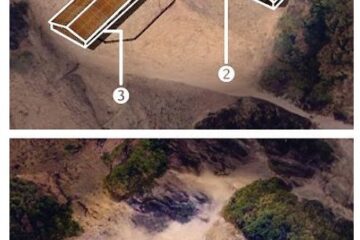A piece of the bigger picture
Hikers fixated on conquering the Pacific Crest Trail share their thoughts — and about five miles — as the route winds through the Angeles National Forest.
Source of this article – Los Angeles Times, May 24, 2005.
By Vernon Loeb, Times Staff Writer
Brandon BRAGG stops on the Pacific Crest Trail and reads a kind of mission statement scrawled on a slip of paper that he keeps in his backpack to remind himself of why he’s making the 2,650-mile journey from Mexico to Canada.”I head toward America and its mountains and its streams and its burning hot deserts and its snow-covered passes and driving rain. I head into the places inside my head that few people ever get to reach.” The 31-year-old arborist from Johnson City, Tenn., recently arrived in the Angeles National Forest after starting out from the Mexican border on April 23. It will be months before he finishes.

AND MILES TO GO: Brandon Bragg treks through the Angeles National Forest on the Pacific Crest Trail. He started in April and should reach Canada by October.The PCT is magnificent and mind-boggling, 101 marathons back-to-back, a journey through six of the country’s seven “eco-zones,” from low desert to old-growth forest to arctic-alpine expanse. Three hundred or so thru-hikers start the trail each year in April at the Mexican border. Fewer than 200 finish by October in Canada.But weekend hikers can easily knock off a bite-size chunk where it crosses the Angeles Crest Highway at Three Points and rolls for 4 1/2 miles through pine-covered hills until it reaches the Sulphur Springs Campground, an idyllic picnic repose. Here, in one of its closest meanders to greater Los Angeles, the vaunted PCT is just 2 or 3 feet wide in most places, mistaken at first for an ordinary footpath.But after just a mile or two, its definition becomes apparent. This is a trail that’s been planned, marked, maintained with rock walls and etched by thousands of sneakers and hiking boots. There is no losing the way.
In just this tiny fraction of the whole, nature’s amenities are abundant — giant boulders, rushing mountain streams, purple wildflowers, avian symphonies, giant pine cones in the dirt. Its most distinctive quality, however, is what’s not there — the white urban noise that’s so hard to escape closer to Los Angeles. Here, near the San Gabriel Mountains’ northern boundary, there’s the wind and the birds and the sound of your footsteps. Stop on the trail — and there’s silence.
Gil Parker, 68, a retired structural engineer from Victoria, British Columbia, affectionately refers to the PCT as the “pathetically convoluted trail” for all its twists, turns and switchbacks, a quality evident even in this short stretch.
He’s hiking 400 miles of the trail — from Cajon Pass in the San Bernardino Mountains to Mt. Whitney in the Sierra Nevada this year. In 2004, Parker hiked from the Mexican border to Cajon Pass and hopes to complete the trail through California, a section at a time, by the time he’s 70. He has already hiked through Oregon and Washington.
Two days before he reached Sulphur Springs on a day with temperatures in the 80s, Parker was battling deep snow on 9,399-foot Mt. Baden-Powell. Such are the PCT’s vagaries.
“You might ask, ‘Why did you start this?’ ” the wiry Parker says and then pauses for a moment to weigh his own question.
“Because other people have done it,” he says. “It’s a challenge…. It’s a meditation for yourself. All you have to worry about is: Where is the trail? Do I have enough food and water? Where am I going to camp? These are the essentials. It gets rid of all the complications you have — cellphones and all the rest of it. You get a chance to examine the real reason for living.”
Bragg, a slight, sandy-haired man wearing a sweat-stained Boston Red Sox hat, is a couple of hours behind Parker on the trail. He started 10 days before most of the other thru-hikers last month and has maintained his lead.
“And I hope to stay ahead of them,” he says.
Bragg hiked the 2,174-mile Appalachian Trail over six months in 2001 and finds the PCT a somewhat gentler trek.
The people who laid out the PCT liked to go around mountains, he says, as opposed to the architects of the Appalachian, who liked to go straight over the peaks.
“It’s a quieter trail, not nearly as many people,” he says.
The particulars
Where: Part of the Pacific Crest Trail in the Angeles National Forest.What: A 9-mile hike with less than 1,000 feet of gain and loss from Three Points to Sulphur Springs Campground.
How: Take the Angeles Crest Highway north for 28 miles and turn left at a sign marked Santa Clara Divide Road/Sulphur Springs. Park in the parking lot here; the trail begins across the street.


